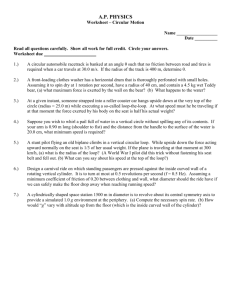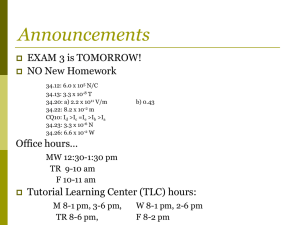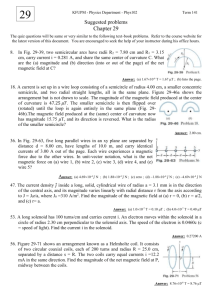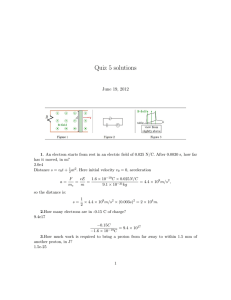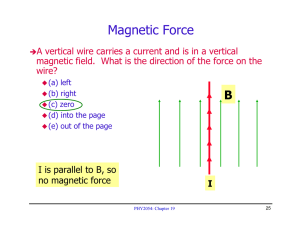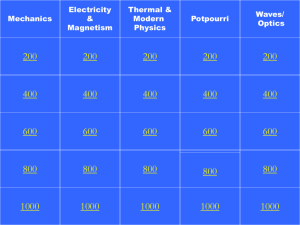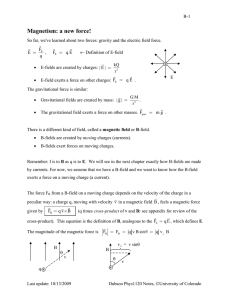radius opposite
advertisement
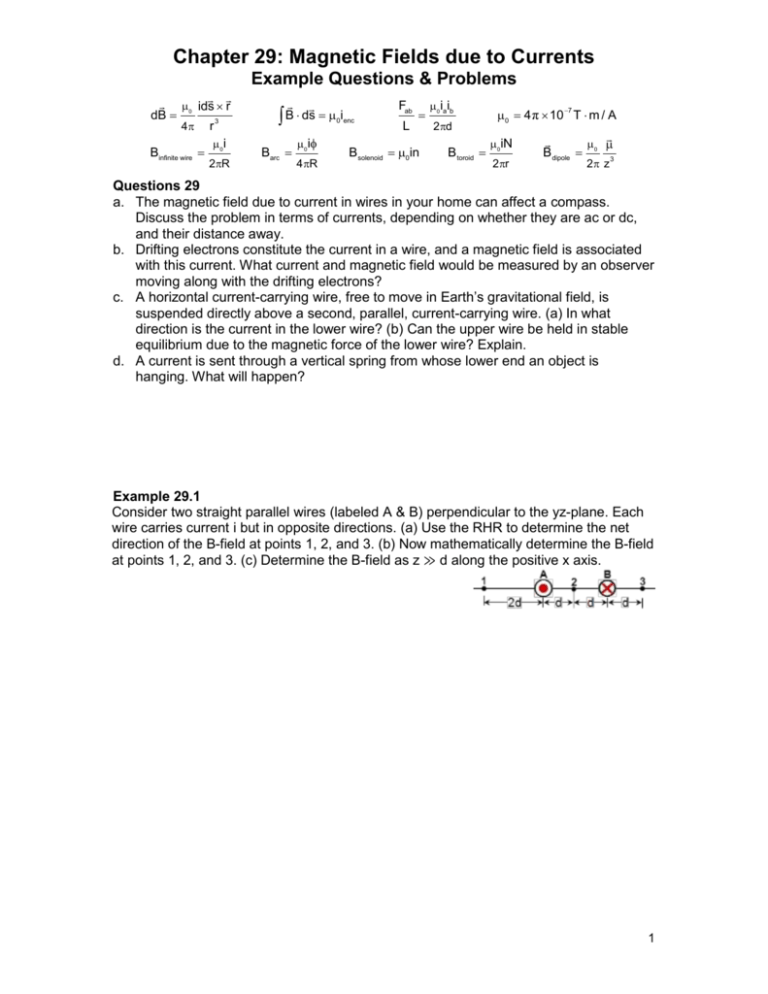
Chapter 29: Magnetic Fields due to Currents Example Questions & Problems dB 0 ids r 4 Binfinite wire r 3 0i 2R B ds i Fab 0 enc Barc 0 i 4 R L B solenoid 0in 0 iaib 2d B toroid 0 4 π 10 7 T m / A 0 iN 2r B dipole 0 2 z 3 Questions 29 a. The magnetic field due to current in wires in your home can affect a compass. Discuss the problem in terms of currents, depending on whether they are ac or dc, and their distance away. b. Drifting electrons constitute the current in a wire, and a magnetic field is associated with this current. What current and magnetic field would be measured by an observer moving along with the drifting electrons? c. A horizontal current-carrying wire, free to move in Earth’s gravitational field, is suspended directly above a second, parallel, current-carrying wire. (a) In what direction is the current in the lower wire? (b) Can the upper wire be held in stable equilibrium due to the magnetic force of the lower wire? Explain. d. A current is sent through a vertical spring from whose lower end an object is hanging. What will happen? Example 29.1 Consider two straight parallel wires (labeled A & B) perpendicular to the yz-plane. Each wire carries current i but in opposite directions. (a) Use the RHR to determine the net direction of the B-field at points 1, 2, and 3. (b) Now mathematically determine the B-field at points 1, 2, and 3. (c) Determine the B-field as z ≫ d along the positive x axis. 1 Example 29.2 Consider a circular conductor of radius R carrying a current i. Since the current is led into and out of the loop through straight sections with equal and opposite current, the B-field quickly goes to zero outside the two wires. Find the B-field at point P along the z-axis. Example 29.3 The figure shows two current segments. The lower segment carries current i1 = 0.40 A and includes a circular arc with radius 5.0 cm, angle 180O, and center point P. The upper segment carries current i2 = 2i1 and includes a circular arc with radius 4.0 cm, angle 120O, and the same center point P. What are the (a) magnitude and (b) direction of the net magnetic field B for the indicated current directions? What are the (c) magnitude and (d) direction of B if i1 is reversed? 2 Example 29.4 A magnetic field of 37.2 T has been achieved at the MIT Francis Bitter National Magnetic laboratory. Find the current needed to achieve such a field (a) 2.00 cm from a straight wire; (b) at the center of a circular oil of radius 42.0 cm that has 100 turns; (c) near the center of a solenoid with radius 2.40 cm, length 32.0 cm and 40,000 turns. Example 29.6 Consider a Helmholtz coils consists of two circular coaxial coils, each of N turns and radius R, separated by distance s. The two coils carry equal currents I in the same direction. (a) Show that the first derivative of the magnitude of the net magnetic field of the coils (dB/dx) vanishes at the midpoint P regardless of the value of s. What would you expect this to be true from symmetry? (b) Show that the second derivative (d2B/dx2) also vanishes at P, provided s = R. This accounts for the uniformity of B near P for this particular coil separation. Solution a. The magnitude of the magnetic field on the axis of a circular loop, a distance z from the loop center, is given by Eq. 29-26: B N0iR2 2(R2 z2 )3 / 2 , where R is the radius of the loop, N is the number of turns, and i is the current. Both of the loops in the problem have the same radius, the same number of turns, and carry the same current. The currents are in the same sense, and the fields they produce are in the same direction in the region between them. We place the origin at the center of the left-hand loop and let x be the coordinate of a point on the axis between the loops. To calculate the field of the left-hand loop, we set z = x in the equation above. The chosen point on the axis is a distance s – x from the center of the right-hand loop. To calculate the field it produces, we put z = s – x in the equation above. The total field at the point is therefore B N0iR2 1 1 2 . 2 2 3/2 2 2 3/2 2 (R x ) (R x 2sx s ) 3 Its derivative with respect to x is N0iR2 3x 3(x s) 2 . 2 2 5/2 2 2 5/2 dx 2 (R x ) (R x 2sx s ) dB When this is evaluated for x = s/2 (the midpoint between the loops) the result is dB dx s/2 N0iR2 3s / 2 3s / 2 2 0 2 2 5/2 2 2 2 5/2 2 (R s / 4) (R s / 4 s s ) independent of the value of s. b. The second derivative is d2B dx 2 N 0iR 2 2 2 5/2 (R x ) 2 3 3 (R x 2sx s ) 2 2 2 5/2 15x 2 (R 2 x 2 )7 / 2 15(x s)2 (R x 2sx s ) 2 2 2 7/2 At x = s/2, d2B dx 2 s/2 N 0iR 2 2 6 (R s / 4) 2 2 5/2 30s 2 / 4 (R s / 4) 2 2 N 0R 2 6(R 2 s2 / 4) 30s2 / 4 2 (R 2 s2 / 4)7 / 2 7/2 s2 R 2 3N 0iR (R 2 s2 / 4)7 / 2 . 2 Clearly, this is zero if s = R. 4





